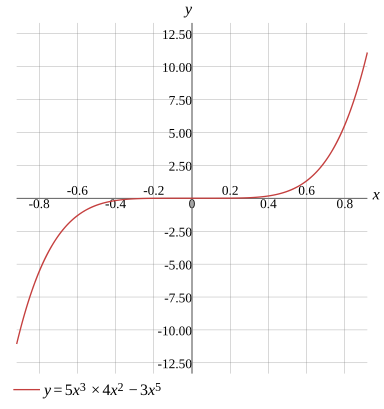Question
Function
Find the inverse
Evaluate the derivative
Find the domain
Load more

f−1(x)=175174x
Evaluate
y=5x3×4x2−3x5
Simplify
More Steps


Evaluate
5x3×4x2−3x5
Multiply
More Steps


Multiply the terms
5x3×4x2
Multiply the terms
20x3×x2
Multiply the terms with the same base by adding their exponents
20x3+2
Add the numbers
20x5
20x5−3x5
Collect like terms by calculating the sum or difference of their coefficients
(20−3)x5
Subtract the numbers
17x5
y=17x5
Interchange x and y
x=17y5
Swap the sides of the equation
17y5=x
Divide both sides
1717y5=17x
Divide the numbers
y5=17x
Take the 5-th root on both sides of the equation
5y5=517x
Calculate
y=517x
Simplify the root
More Steps


Evaluate
517x
To take a root of a fraction,take the root of the numerator and denominator separately
5175x
Multiply by the Conjugate
517×51745x×5174
Calculate
175x×5174
Calculate
More Steps


Evaluate
5x×5174
The product of roots with the same index is equal to the root of the product
5x×174
Calculate the product
5174x
175174x
y=175174x
Solution
f−1(x)=175174x
Show Solution

Testing for symmetry
Testing for symmetry about the origin
Testing for symmetry about the x-axis
Testing for symmetry about the y-axis
Symmetry with respect to the origin
Evaluate
y=5x34x2−3x5
Simplify the expression
y=17x5
To test if the graph of y=17x5 is symmetry with respect to the origin,substitute -x for x and -y for y
−y=17(−x)5
Simplify
More Steps


Evaluate
17(−x)5
Rewrite the expression
17(−x5)
Multiply the numbers
−17x5
−y=−17x5
Change the signs both sides
y=17x5
Solution
Symmetry with respect to the origin
Show Solution

Solve the equation
Solve for x
Solve for y
x=175174y
Evaluate
y=5x3×4x2−3x5
Simplify
More Steps


Evaluate
5x3×4x2−3x5
Multiply
More Steps


Multiply the terms
5x3×4x2
Multiply the terms
20x3×x2
Multiply the terms with the same base by adding their exponents
20x3+2
Add the numbers
20x5
20x5−3x5
Collect like terms by calculating the sum or difference of their coefficients
(20−3)x5
Subtract the numbers
17x5
y=17x5
Swap the sides of the equation
17x5=y
Divide both sides
1717x5=17y
Divide the numbers
x5=17y
Take the 5-th root on both sides of the equation
5x5=517y
Calculate
x=517y
Solution
More Steps


Evaluate
517y
To take a root of a fraction,take the root of the numerator and denominator separately
5175y
Multiply by the Conjugate
517×51745y×5174
Calculate
175y×5174
Calculate
More Steps


Evaluate
5y×5174
The product of roots with the same index is equal to the root of the product
5y×174
Calculate the product
5174y
175174y
x=175174y
Show Solution

Rewrite the equation
r=0r=417cos5(θ)sin(θ)r=−417cos5(θ)sin(θ)
Evaluate
y=5x3×4x2−3x5
Simplify
More Steps


Evaluate
5x3×4x2−3x5
Multiply
More Steps


Multiply the terms
5x3×4x2
Multiply the terms
20x3×x2
Multiply the terms with the same base by adding their exponents
20x3+2
Add the numbers
20x5
20x5−3x5
Collect like terms by calculating the sum or difference of their coefficients
(20−3)x5
Subtract the numbers
17x5
y=17x5
Move the expression to the left side
y−17x5=0
To convert the equation to polar coordinates,substitute x for rcos(θ) and y for rsin(θ)
sin(θ)×r−17(cos(θ)×r)5=0
Factor the expression
−17cos5(θ)×r5+sin(θ)×r=0
Factor the expression
r(−17cos5(θ)×r4+sin(θ))=0
When the product of factors equals 0,at least one factor is 0
r=0−17cos5(θ)×r4+sin(θ)=0
Solution
More Steps


Factor the expression
−17cos5(θ)×r4+sin(θ)=0
Subtract the terms
−17cos5(θ)×r4+sin(θ)−sin(θ)=0−sin(θ)
Evaluate
−17cos5(θ)×r4=−sin(θ)
Divide the terms
r4=17cos5(θ)sin(θ)
Evaluate the power
r=±417cos5(θ)sin(θ)
Separate into possible cases
r=417cos5(θ)sin(θ)r=−417cos5(θ)sin(θ)
r=0r=417cos5(θ)sin(θ)r=−417cos5(θ)sin(θ)
Show Solution

Graph
